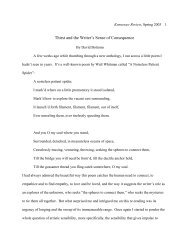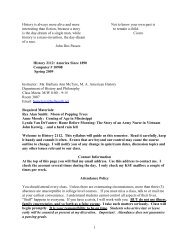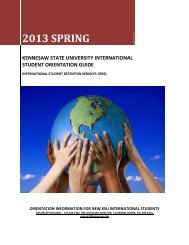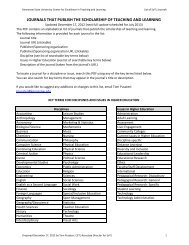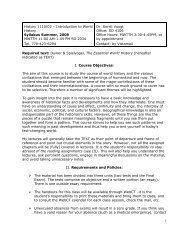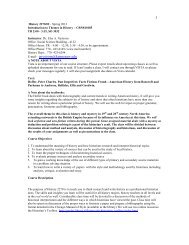Food, Gender and Cultural Hegemony - Kennesaw State University
Food, Gender and Cultural Hegemony - Kennesaw State University
Food, Gender and Cultural Hegemony - Kennesaw State University
You also want an ePaper? Increase the reach of your titles
YUMPU automatically turns print PDFs into web optimized ePapers that Google loves.
Cualli 133<br />
Spaniards was imperative" Foster argues that colonial culture was "blocked out" <strong>and</strong><br />
became "crystallized" (Foster 232-233). 1<br />
This analysis is also pertinent to the incorporation of indigenous cuisine into<br />
the Spanish creole culture, <strong>and</strong> of Spanish foods into the indigenous diet. According to<br />
Richard N. Adams, "The major change in the diet of Meso-America…is not a result of<br />
a gradual diffusion of European products into the older Meso-American system, but of<br />
a gradual <strong>and</strong> differential shift of the entire culture to a new tradition," (Adams 8). If<br />
some easily accepted food ways were transferred quickly in those first decades (i.e.<br />
chickens into indigenous culture; turkeys <strong>and</strong> tomatoes into Spanish culture), other<br />
foods less similar to that of the recipient culture took longer to be accepted.<br />
II. Spain <strong>and</strong> Mexico: pre-contact period<br />
<strong>Food</strong> is an important aspect of culture, though it is also unavoidably connected<br />
with climate <strong>and</strong> place. As Daniel Roche wrote, [eating practice] "is perhaps the<br />
domain in which needs, symbolic forms <strong>and</strong> class oppositions intersect with the<br />
greatest intensity," (Roche 22). In the early modern period biology (<strong>and</strong> nutrition) was<br />
seen as intimately related to the capacity for civilized behavior. The common Spanish<br />
idea of blood as a vehicle initially of religious faith <strong>and</strong> later as a mark of social<br />
condition is probably related to medieval physiological theory according to which the<br />
mother's blood fed the child in the womb <strong>and</strong> then, transformed into milk, fed the baby<br />
outside the womb as well. A child's substance was provided by the mother's blood.<br />
Hence purity of blood meant descent from Christian women (Bynum 182). The origin<br />
of the idea of "clean blood" dates from the emergence of the issue of religious purity<br />
in the fifteenth century (Kamen 321-56). That was gradually transformed into the<br />
principle of race. Consistent with these views was the belief that certain foods were<br />
appropriate <strong>and</strong> necessary for Christians <strong>and</strong> for a civilized life. Roche points out that<br />
"Religious metaphors <strong>and</strong> the terminology of the Gospels conveyed this cosmic<br />
symbolism: fishing, harvesting, the wine-harvest, the bread <strong>and</strong> wine of the Lord,"<br />
(Roche 247). Culinary customs related to Christianity were even imposed on the<br />
natives believing that this would allow them to reach salvation (Parasecoli in Kumin<br />
[Type text]



